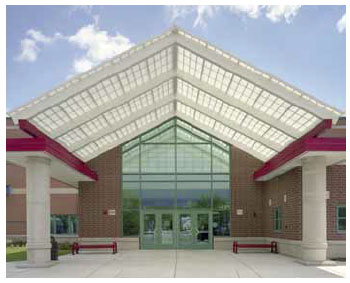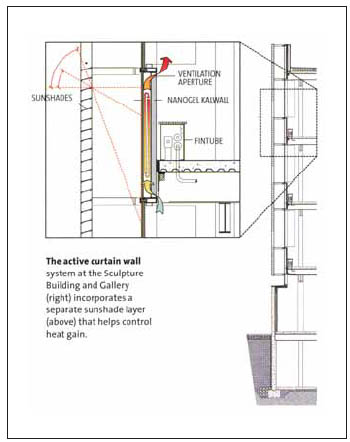High-Performance Envelopes: Meeting New Energy Codes with Manufactured Systems
New Focus on CI and U-Factor
One of the benefits of panelized and preengineered enclosures is the ability to specify a continuous layer of insulation that is not interrupted by metal studs, girts or steel columns that can act as thermal bridges carrying heat and cold unintentionally across the envelope assembly. “With a system like EIFS, the insulation is installed on the exterior of the building, so thermal bridging is eliminated -resulting in a 20 to 30 percent reduction in annual energy costs,” says Dazel.

IMAGE COURTESY OF KALWALL
Translucent skylights aid energy efficiency at the Roosevelt K-2 Primary School in Elkhart, Ind., by offering enough daylight to light interior spaces even in the dead of an Indiana winter.
In fact, about 90 percent of U.S. jurisdictions now mandate CI for all enclosures above grade that are framed with heavy or light-gauge steel, except the areas across the southern states located in DOE climate zones 1 and 2.
“Energy codes have changed so much that the code-mandated R-values are much higher now for opaque walls, although window R-values haven’t changed as much,” says Boyer. “About 10 years ago in climate zone 4, ASHRAE 90.1 required R-8.1; today the minimum is R-15.6 -almost double -for solid wall areas.” An even more restrictive insulating value of at least R-10 is required across the entire envelope in the 2012 IgCC and ASHRAE standard 189.1, the highest now mandated. Cavity insulation must supplement the CI layer to achieve at least R-13 in climate zones 3 and up.
By definition, CI must run across the enclosures without interruption, such as mineral wool, spray foam or rigid foam insulation. It can be installed within the enclosure assembly, on the exterior or rior, depending on which approach is best for controlling associated concerns, such as condensation and heating/cooling efficiency. However, Zabcik says, “There is quite a bit of misinformation about continuous insulation requirements in the marketplace.” For example, the purpose of requiring CI is to make the total in-place thermal performance of an assembly closer to that of insulation alone with no breaks by limiting thermal bridges. While R-value tables in the codes provide simplified descriptions of assemblies needed to get to a certain performance level, they are often misunderstood to be an absolute code requirement, which is not the case, Zabcik explains. “Most codes offer a U-factor compliance path as well, and at the end of the day, the lowest total assembly U-factor is the winner, regardless of whether it uses continuous insulation or not.”
In other words, says the DOE, if the full specified assembly provides a U-factor that is “less than or equal to the appropriate climate- zone construction requirements,” it doesn’t matter what kinds of insulation or R-values are used, Zabcik notes. The IECC Table C402.2 provides details on both prescriptive and performance-based compliance. A whole-building energy analysis is another alternative method for determining if the enclosure design is adequate.
The ROI of CI
Examples of the benefits of CI are not hard to come by. In designing the Metro Career Academy in Oklahoma City, for example, architect Fred Quinn substituted a brick-face EIFS system instead of brick masonry or veneer. This decision not only cut costs and at least 15 weeks from the construction plan, but it also ensured that an uninterrupted blanket of CI would earn energy savings of at least 34 percent and cut energy costs by almost 43 percent annually. For a single 12-month period, electric usage was a full one-third lower than a baseline established by another of the academy’s campus buildings, saving about $17,500; natural gas use was lower by almost three quarters, for a savings of about $4,800.
By using continuous exterior insulation instead of clay brick, the Metro Career Academy became the first LEED Gold-certified building for career technologies in Oklahoma, says Dazel. “The efficient, sustainable design of this high-performance building was important for it to fulfill its purpose,” he adds.
Another option for CI similar to EIFS is insulated stucco, says Larsen. “Stucco has been used for generations and provides a highly desired aesthetic and a strong outer shell to act as the cladding and thermal continuity for a structure,” she explains. “Like EIFS, stucco-clad wall assemblies can be designed with continuous insulation of EPS or other insulation types, up to two inches thick, thus offering an advanced, energy-efficient assembly.”
When using the EPS or other foam insulation, the façade assemblies must also meet the requirements of the National Fire Protection Association (NFPA) standard NFPA 285. Required in the IBC, the test is used to show that the combustible foam plastic insulation does not propagate flame across the exterior or into the wall assembly. It involves a relatively elaborate setup: a fullscale, two-story mockup of the proposed envelope construction is subjected to a fire plume that is emanating from a room below. Wall assemblies that pass NFPA 285 show limited vertical and horizontal spread of the fire, as measured by temperatures in the wall area and visual damage, measured in feet.
The main challenge of the test? It does not apply to individual materials, according to Jesse J. Beitel, a senior scientist, Hughes Associates. “NFPA 285 is a test of a complete wall assembly and applies only to the tested construction -similar to ASTM E119,” says Beitel. Substitutions of one material for another may cause different test results, including combustible materials such as insulation and weather-resistive barriers (WRBs). This fact tends to lead many project teams to use manufactured panels and other pre-engineered assemblies because they have typically been tested and approved to meet NFPA 285.
Air Barriers, Getting Better

IMAGE COURTESY OF KALWALL
Manufactured systems are also effective at controlling solar heat gain, which is another contributing factor to overall energy efficiency.
As noted by Beitel, the codes require that if any combustible WRBs are included in a wall design more than 40 feet tall, they must meet the standard test for flame propagation. Because WRBs -including air barriers, vapor barriers and waterproofing layers -are now called for by many codes, project teams have even more incentive to consider using enclosure assemblies that have already passed the fire tests.
“The energy codes and standards have numerous, specific requirements for air barriers,” says Larsen. “By using air barriers, climate-controlled interior air stays inside and uncontrolled air stays out of the building, reducing the building’s HVAC system energy consumption to maintain the desired air temperature and humidity.” Air barrier materials include the company’s liquid-applied combined air barrier and WRB, as well as an array of self-adhering sheets, medium-density sprayed polyurethane foam (SPF), and mechanically fastened commercial building wraps and board stocks, according to the Air Barrier Association of America (ABAA).
The key test for any air barrier material is ASTM E2178 – Standard Test Method for Air Permeance of Building Materials. Different from “air leakage” through openings in an air barrier, permeance describes the capacity of the product used to allow air to migrate through the body of the material, says ABAA. Barriers are considered to be impermeable even though they may allow some air through; one definition widely used in the codes is the standard ASTM E-2357, which states that an air barrier material must have an air permeance of less than 0.02 liters per second per square meter at a pressure differential of 75 Pascal, usually abbreviated 0.2 L/(s·m2) @ 75 Pa. Water-vapor permeance is another measure for air barriers that are also used to resist vapor intrusion. Other tests are recommended for the barrier materials, including the following required for all products listed by the ABAA:
- Self-adhered sheet air barriers are tested for air permeance, water vapor permeance, resistance to puncture, tensile strength, water resistance, peel or stripping strength of adhesive bonds, lap adhesion, low temperature flexibility, nail sealability, pull adhesion, tear initiation and propagation, and crack bridging.
- Liquid-applied membranes are tested for air permeance, water-vapor permeance, nail sealability, pull adhesion and crack bridging.
- Medium-density SPF is tested for air permeance, water-vapor permeance, flame-spread characteristics, thermal transmission, compressive strength, density, tensile strength, dimensional stability, water absorption, open cell content, pull adhesion and crack bridging.
- Mechanically fastened commercial building wraps are tested for air permeance, water-vapor permeance, dry tensile strength or dry breaking force, pliability and water resistance.
- Boardstock, or rigid cellular thermal insulation board, is tested for air permeance, water-vapor permeance, compressive strength, thermal resistance, flexural strength, water absorption, dimensional stability and tensile strength.
Once the right material is selected, the next challenge is for the project team to ensure the entire air-barrier assembly conforms to the codes and meets the requisite level of performance. In this way, panelized and manufactured systems help to ensure the air barrier is structurally supported and continuous across the entire façade area. “When it comes to barriers for air and water, the most important thing is that the products are not just tested as a material or single component, but that the assemblies meet all test criteria,” says Keller. “For panels that are already fabricated, you don’t have to worry about onsite coordination of the exterior cladding, so there is less chance for errors and there are fewer joints to seal.”
A number of federal agencies require air barriers for their building projects, and some jurisdictions and several states have already made air barriers a firm mandate, including Massachusetts. “As more codes -such as the DOE’s October 18, 2013, mandate - come into effect across the country, governing and regulatory bodies are constantly requiring builders and designers to use techniques that better control air and water barriers,” says Dazel, encouraging architects, builders and building owners to seek out solutions for ensuring both their new construction and renovation projects meet requirements.
The stakes are high for individual building performance as well as across the national stock of facilities. According to DOE, as much as 40 percent of the energy used for mechanical systems is required to counteract losses from uncontrolled air leakage. The agency says its goal to reduce building energy consumption by 50 percent before 2020 will require the use of more air barriers.
Many of the panelized, prefabricated enclosure systems have included continuous, structural air barriers for decades. “Metal panel systems have always been good air barriers,” says Zabcik. “Our industry has used assembly air-barrier tests long before they were a code requirement. We learned many years ago that it just takes good, careful installation.”









